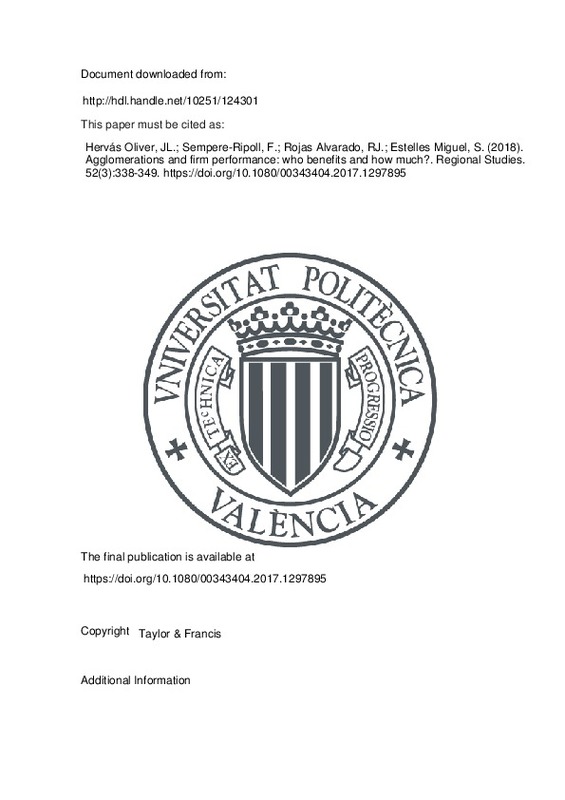JavaScript is disabled for your browser. Some features of this site may not work without it.
Buscar en RiuNet
Listar
Mi cuenta
Estadísticas
Ayuda RiuNet
Admin. UPV
Agglomerations and firm performance: who benefits and how much?
Mostrar el registro sencillo del ítem
Ficheros en el ítem
| dc.contributor.author | Hervás Oliver, Jose Luis
|
es_ES |
| dc.contributor.author | Sempere-Ripoll, Francisca
|
es_ES |
| dc.contributor.author | ROJAS ALVARADO, RONALD JOANNY
|
es_ES |
| dc.contributor.author | Estelles Miguel, Sofia
|
es_ES |
| dc.date.accessioned | 2019-07-27T20:02:09Z | |
| dc.date.available | 2019-07-27T20:02:09Z | |
| dc.date.issued | 2018 | es_ES |
| dc.identifier.issn | 0034-3404 | es_ES |
| dc.identifier.uri | http://hdl.handle.net/10251/124301 | |
| dc.description.abstract | [EN] Agglomerations and firm performance: who benefits and how much? Regional Studies. Agglomeration can generate gains. If it does, how does it work and how are those gains distributed across agglomerated firms? The paper examines the effect of localization externalities on innovation. Localization externalities are measured as industry specialization or a firm s colocation in a relatively high own-industry employment region. By analyzing a large dataset of 6697 firms integrated with another regional agglomeration-related dataset, results show that (1) co-location in an agglomeration has a positive influence on a firm s innovative performance; and (2) firms benefit heterogeneously from agglomerations, with benefits being distributed asymmetrically. Agglomeration gains exist but not all firms benefit equally. | es_ES |
| dc.description.sponsorship | Financial support was provided by the Spanish Ministry of Economics, Industry and Competitiveness [research grant ECO:2015-63645-R] (Mineco/Feder), Open Innovation in Clusters. | es_ES |
| dc.language | Inglés | es_ES |
| dc.publisher | Taylor & Francis | es_ES |
| dc.relation.ispartof | Regional Studies | es_ES |
| dc.rights | Reserva de todos los derechos | es_ES |
| dc.subject | Innovation | es_ES |
| dc.subject | Localization externalities | es_ES |
| dc.subject | Firm performance | es_ES |
| dc.subject | Agglomeration | es_ES |
| dc.subject.classification | ORGANIZACION DE EMPRESAS | es_ES |
| dc.title | Agglomerations and firm performance: who benefits and how much? | es_ES |
| dc.type | Artículo | es_ES |
| dc.identifier.doi | 10.1080/00343404.2017.1297895 | es_ES |
| dc.relation.projectID | info:eu-repo/grantAgreement/MINECO//ECO2015-63645-R/ES/INNOVACION ABIERTA EN CLUSTERS: UN ENFOQUE DE CAPACIDADES PARA EXPLICAR LA FORMACION DE COMPETENCIAS EN EMPRESAS LOCALIZADAS Y LA EVOLUCION DE LOS CLUSTERS/ | es_ES |
| dc.rights.accessRights | Abierto | es_ES |
| dc.date.embargoEndDate | 2019-09-30 | es_ES |
| dc.contributor.affiliation | Universitat Politècnica de València. Departamento de Ingeniería de la Construcción y de Proyectos de Ingeniería Civil - Departament d'Enginyeria de la Construcció i de Projectes d'Enginyeria Civil | es_ES |
| dc.contributor.affiliation | Universitat Politècnica de València. Departamento de Organización de Empresas - Departament d'Organització d'Empreses | es_ES |
| dc.description.bibliographicCitation | Hervás Oliver, JL.; Sempere-Ripoll, F.; Rojas Alvarado, RJ.; Estelles Miguel, S. (2018). Agglomerations and firm performance: who benefits and how much?. Regional Studies. 52(3):338-349. https://doi.org/10.1080/00343404.2017.1297895 | es_ES |
| dc.description.accrualMethod | S | es_ES |
| dc.relation.publisherversion | https://doi.org/10.1080/00343404.2017.1297895 | es_ES |
| dc.description.upvformatpinicio | 338 | es_ES |
| dc.description.upvformatpfin | 349 | es_ES |
| dc.type.version | info:eu-repo/semantics/publishedVersion | es_ES |
| dc.description.volume | 52 | es_ES |
| dc.description.issue | 3 | es_ES |
| dc.subject.asignatura | Gestión de la política industrial y tecnológica 10624 / M - Grado en gestión y administración pública 146 | es_ES |
| dc.relation.pasarela | S\336058 | es_ES |
| dc.contributor.funder | Ministerio de Economía y Competitividad | es_ES |







![[Cerrado]](/themes/UPV/images/candado.png)

